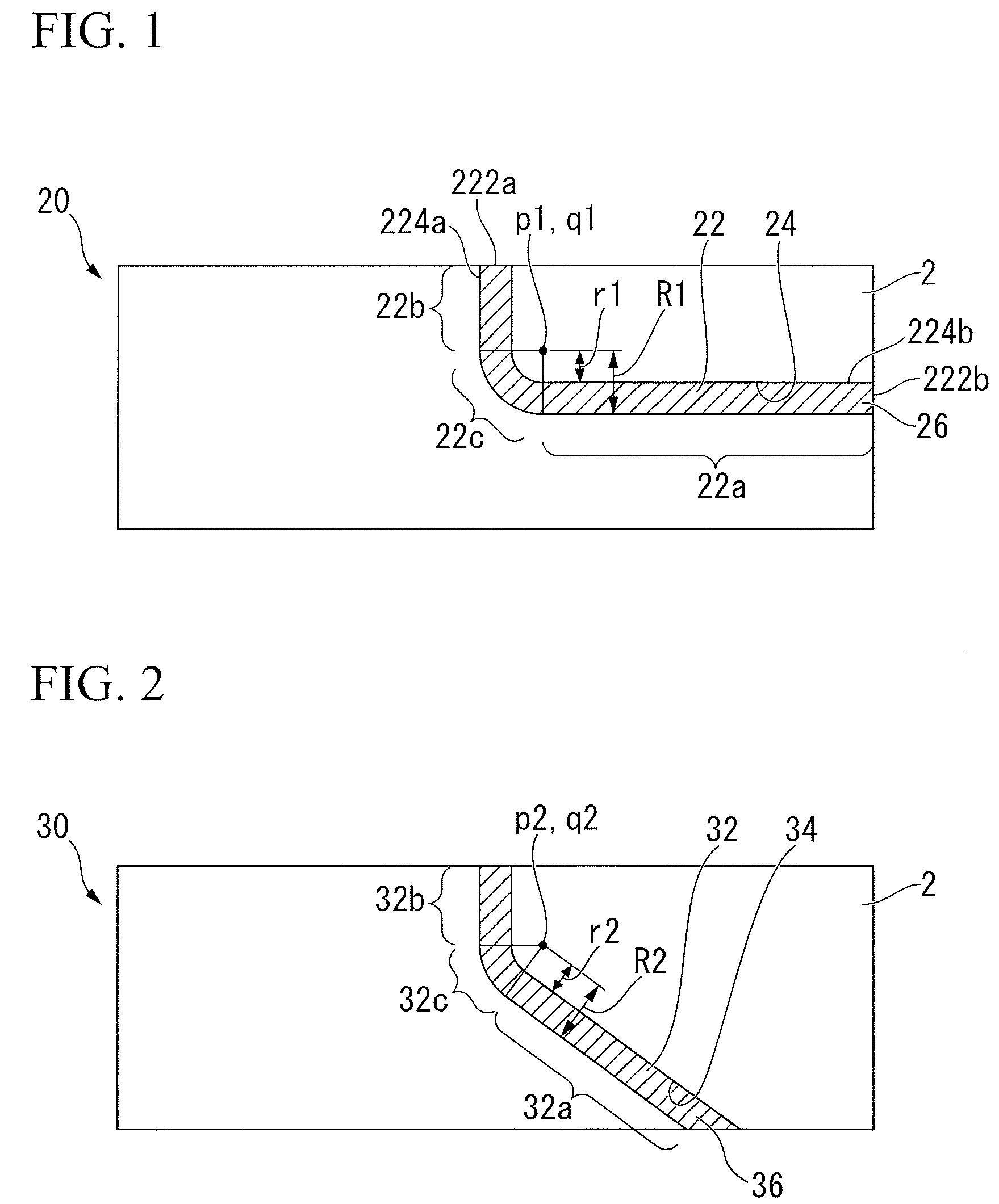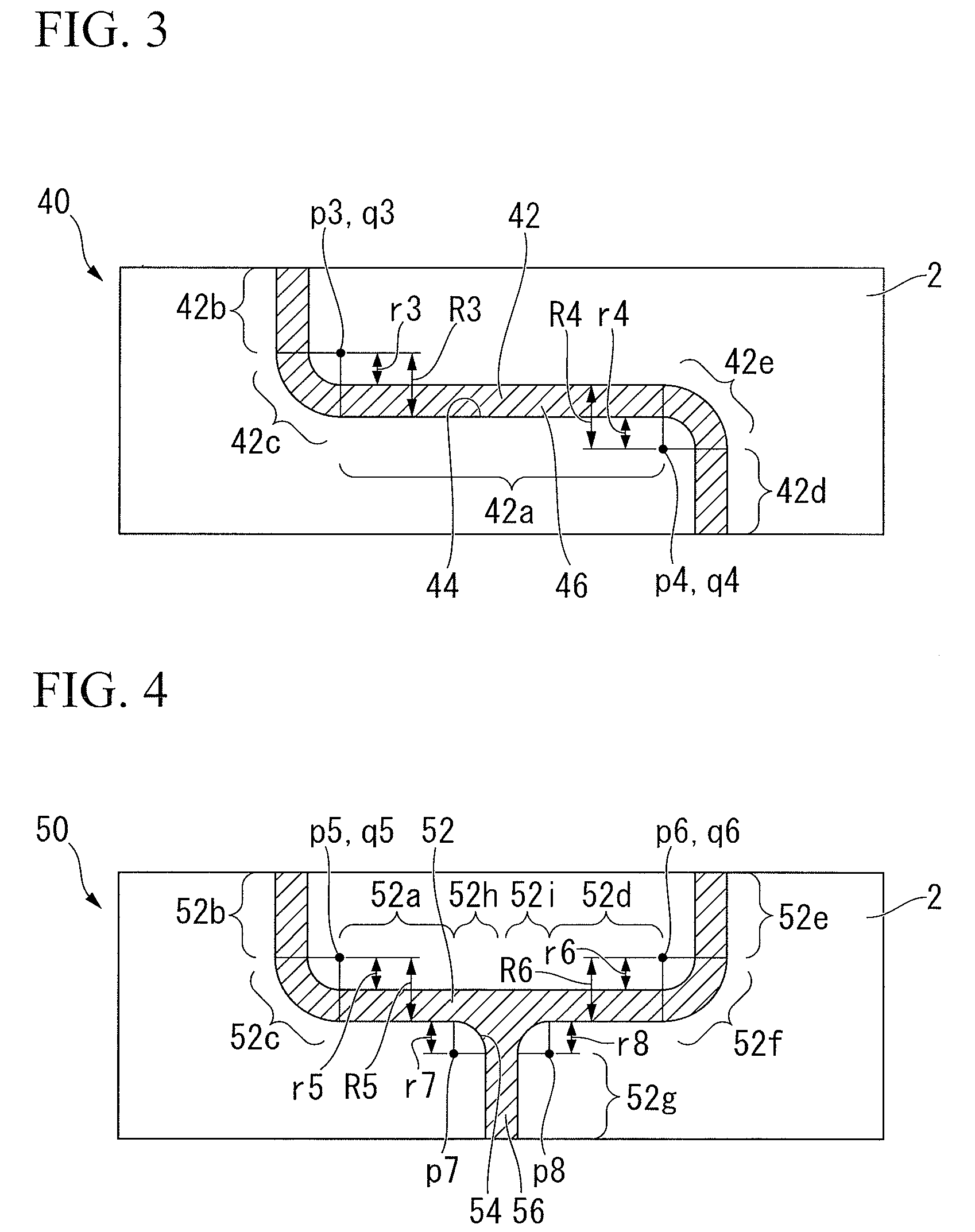Through wiring substrate and manufacturing method thereof
a technology of wiring substrate and manufacturing method, which is applied in the direction of semiconductor/solid-state device details, nuclear engineering, and high-frequency signals, can solve the problems of increased transmission loss of electrical signals, particularly of high-frequency signals, via the through-wire, and poor conductivity, so as to achieve smooth bend parts, the effect of reducing the number of defects and improving the quality of the produ
- Summary
- Abstract
- Description
- Claims
- Application Information
AI Technical Summary
Benefits of technology
Problems solved by technology
Method used
Image
Examples
first embodiment
[0035]FIG. 1 is a cross-sectional view of a through wiring substrate 20 according to the invention. The through wiring substrate 20 includes a through-wire 22. The through-wire 22 is formed by providing a through-hole 24 that penetrates between one face (a top face or a bottom face; first face) constituting a single substrate 2 and one side face (second face), and filling, or forming a film of, an electrically-conductive substance 26 into this through-hole 24. The through-hole 24 has a bend part (curved part) 22c. The outer peripheral part and inner peripheral part of the longitudinal cross-section of this bend part 22c are formed in a circular arc shape. As shown in FIG. 1, this bend part, in the longitudinal cross-section, includes an inner peripheral part that is curved in a recessed shape, and an outer peripheral part that is curved in a protruding shape. The through-hole 24 includes a linear part 22b, the bend part 22c, and a linear part 22a, which are continuously disposed. Th...
second embodiment
[0045]FIG. 2 is a cross-sectional view of a through wiring substrate 30 according to the invention. The through wiring substrate 30 includes a through-wire 32, which is formed by providing a through-hole 34 that penetrates between one face (a top face or a bottom face; first face) and another face (a bottom face or a top face; second face) constituting a single substrate 2, and filling, or forming a film of, an electrically-conductive substance 36 in this through-hole 34. The through-hole 34 has a bend part (curved part) 32c, and the outer peripheral part and inner peripheral part of the longitudinal cross-section of the bend part 32c are formed in a circular arc shape.
[0046]The cross-section of the through wiring substrate 30 of FIG. 2 is a longitudinal cross-section along the center line of the through-wire 32. One end of the through-wire 32 is a first conductive part exposed at one face (first face) of the through wiring substrate 30. A linear part 32b extends from one end of the...
third embodiment
[0055]FIG. 3 is a cross-sectional view of a through wiring substrate 40 according to the invention. The through wiring substrate 40 includes a through-wire 42, which is formed by providing a through-hole 44 that penetrates between one face (a top face or a bottom face; first face) and another face (a bottom face or a top face; second face) constituting a single substrate 2, and filling, or forming a film of, an electrically-conductive substance 46 in this through-hole 44. The through-hole 44 has a first bend part 42c and a second bend part 42e. The outer peripheral part and inner peripheral part of the longitudinal cross-section of the first bend part 42c, and the outer peripheral part and the inner peripheral part of the longitudinal cross-section of the second bend part 42e are each formed in a circular arc shape. In other words, the through-wire includes the first bend part 42c and the second bend part 42e, and the outer peripheral parts and inner peripheral parts of the first be...
PUM
 Login to View More
Login to View More Abstract
Description
Claims
Application Information
 Login to View More
Login to View More - R&D
- Intellectual Property
- Life Sciences
- Materials
- Tech Scout
- Unparalleled Data Quality
- Higher Quality Content
- 60% Fewer Hallucinations
Browse by: Latest US Patents, China's latest patents, Technical Efficacy Thesaurus, Application Domain, Technology Topic, Popular Technical Reports.
© 2025 PatSnap. All rights reserved.Legal|Privacy policy|Modern Slavery Act Transparency Statement|Sitemap|About US| Contact US: help@patsnap.com



